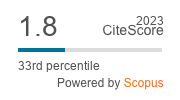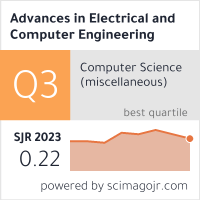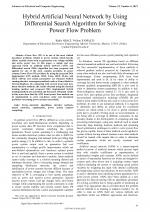| 4/2019 - 7 |
Hybrid Artificial Neural Network by Using Differential Search Algorithm for Solving Power Flow ProblemABACI, K. |
| View the paper record and citations in |
| Click to see author's profile in |
| Download PDF |
Author keywords
heuristic algorithms, iterative methods, neural networks, optimization, power system analysis computing
References keywords
power(23), neural(13), algorithm(11), optimal(9), networks(8), flow(8), artificial(7), training(6), systems(6), search(6)
Blue keywords are present in both the references section and the paper title.
About this article
Date of Publication: 2019-11-30
Volume 19, Issue 4, Year 2019, On page(s): 57 - 64
ISSN: 1582-7445, e-ISSN: 1844-7600
Digital Object Identifier: 10.4316/AECE.2019.04007
Web of Science Accession Number: 000500274700006
SCOPUS ID: 85077289267
Abstract
Power flow (PF) is in one of the most studied non-linear problems related to power systems which heavily affects security issues such as generation cost, voltage stability and active power loss. In this paper, a simple and new approach based on artificial neural network (ANN) and differential search (DSA) algorithm has been proposed and applied for one of the most complex problems in power systems, Power Flow (PF) problem. By using the proposed DSA implemented ANN method, IEEE 9-bus, IEEE 30-bus and IEEE 118-bus test system parameters are obtained without running iterative convergence methods such as Gauss-Siedel or Newton-Raphson. By comparing with several most used non-linear iterative methods, the results obtained using the classical training method and proposed DSA implemented hybrid training methods are presented and discussed. Obtained results in this work show that the ANN based power flow method can be implemented to solve non-linear static and dynamical problems concerning power systems successfully. |
| References | | | Cited By «-- Click to see who has cited this paper |
| [1] K. Abaci, V. Yamacli, "Optimal Reactive-Power Dispatch Using Differential Search Algorithm," Electrical Engineering, vol. 99(1), pp. 213-225, 2017. [CrossRef] [Web of Science Times Cited 34] [SCOPUS Times Cited 50] [2] J. A. Momoh, J. Z. Zhu, "Improved Interior Point Method For OPF Problems," IEEE Trans. on Power Systems, vol. 14(3), pp. 1114-1120, 1999. [CrossRef] [Web of Science Times Cited 160] [SCOPUS Times Cited 207] [3] J. Carpentier, "Contribution a l'etude du Dispatching Economique," Bulletin de la Societe Francaise des Electriciens, vol. 3, pp.431-474, 1962. [4] A. A. Abou El, M. A. Abido, "Optimal Power Flow Using Tabu Search Algorithm," Electric Power Components and Systems, vol. 30(5), pp. 469-483, 2002. [CrossRef] [Web of Science Times Cited 295] [SCOPUS Times Cited 393] [5] R. Mota-Palomino, V. H. Quintana, "Sparse Reactive Power Scheduling By A Penalty-Function Linear Programming Technique," IEEE Transactions on Power Systems, vol. 1(3), pp. 31-39, 1986. [CrossRef] [Web of Science Times Cited 107] [SCOPUS Times Cited 134] [6] R. C. Burchett, H. Happ, D. R. Vierath, "Quadratically Convergent Optimal Power Flow," IEEE Trans. on Power Appar. Syst., vol. 103(11), pp. 3264-3276, 1984. [CrossRef] [Web of Science Times Cited 220] [SCOPUS Times Cited 294] [7] D. I. Sun, B. Ashley, B. Brewer, A. Hughes, "Optimal Power Flow by Newton Approach," IEEE Trans. Power Appar. Syst., vol. 103(10), pp. 2864-2875, 1984. [CrossRef] [Web of Science Times Cited 531] [SCOPUS Times Cited 754] [8] A. Santos, Jr. da Costa, "Optimal Power Flow Solution By Newton's Method Applied To An Augmented Lagrangian Function," IEEE Proc. Gener. Transm. Distrib. Vol 142(1), pp. 33-36, 1995. [CrossRef] [Web of Science Times Cited 89] [SCOPUS Times Cited 126] [9] M. Rahli, P. Pirotte, "Optimal Load Flow Using Sequential Unconstrained Minimization Technique Method Under Power Transmission Losses Minimization," Electrical Power System Research, vol 52, pp. 61-64, 1999. [CrossRef] [Web of Science Times Cited 45] [SCOPUS Times Cited 52] [10] X. Yan, V.H. Quintana, "Improving An Interior Point Based OPF By Dynamic Adjustments of Step Sizes and Tolerances," IEEE Trans. Power Syst., vol. 14(2), pp. 709-717, 1999. [CrossRef] [Web of Science Times Cited 134] [SCOPUS Times Cited 196] [11] V. Veerasamy, R. Ramachandran, M. Thirumeni, B. Madasamy, "Load Flow Analysis Using Generalised Hopfield Neural Network," IET Generation, Transmission & Distribution, vol. 12, pp. 1765-1773, 2017. [CrossRef] [Web of Science Times Cited 15] [SCOPUS Times Cited 18] [12] D. Karaboga, B. Akay, "Artificial Bee Colony (ABC) Algorithm on Training Artificial Neural Networks," in Proc. 15th Signal Processing and Communications Applications, Eskisehir, 2007, pp. 128-139. [13] D. Karaboga, C. Ozturk, "Neural Networks Training By Artificial Bee Colony Algorithm on Pattern Classification," Neural Network World, vol. 19, pp. 279-292, 2009. [14] J. A. Bullinaria, K. AlYahya, "Artificial Bee Colony Training of Neural Networks: Comparison With Back-Propagation" Memetic Comp. vol. 6, pp. 6-171, 2014. [CrossRef] [Web of Science Times Cited 23] [SCOPUS Times Cited 31] [15] T. Olsson, K. Magnusson, "Training artificial neural networks with genetic algorithms for stock forecasting" KTH Royal Institute Of Technology School Of Computer Science And Communication, Stockholm, 2016, vol. 1. [16] L. Hu, L Q, K. Mao, W. Chen, X. Fu, "Optimization of Neural Network By Genetic Algorithm for Flowrate Determination In Multipath Ultrasonic Gas Flowmeter," IEEE Sensors Journal, vol. 16(5), pp. 1158-1167, 2016. [CrossRef] [Web of Science Times Cited 24] [SCOPUS Times Cited 34] [17] F. Valdez, O. Castillo, P. Melin, "Ant Colony Optimization for the Design Of Modular Neural Networks in Pattern Recognition," in Proc. International Joint Conference on Neural Networks, Canada, 2016, pp. 24-29. [CrossRef] [SCOPUS Times Cited 10] [18] C. Juang, Y. Yeh, "Multiobjective Evolution of Biped Robot Gaits Using Advanced Continuous Ant-Colony Optimized Recurrent Neural Networks," IEEE Trans. on Cybernetics, vol. 48(6), pp. 1910-1922, 2018. [CrossRef] [Web of Science Times Cited 52] [SCOPUS Times Cited 68] [19] P. Civicioglu, "Transforming Geocentric Cartesian Coordinates to Geodetic Coordinates by Using Differential Search Algorithm," Computers & Geosciences, vol. 46, pp. 229-247, 2012. [CrossRef] [Web of Science Times Cited 325] [SCOPUS Times Cited 402] [20] K. Abaci, V. Yamacli, "Differential Search Algorithm for Solving Multi-Objective Optimal Power Flow Problem," International Journal of Electrical Power & Energy Systems, vol. 79, pp. 1-10, 2016. [CrossRef] [Web of Science Times Cited 146] [SCOPUS Times Cited 191] [21] T. Kurban, P. Civicioglu, R. Kurban, E. Besdok "Comparison of Evolutionary and Swarm Based Computational Techniques for Multilevel Color Image Thresholding," Applied Soft Computing, vol. 23(1), pp. 128-143, 2014. [CrossRef] [Web of Science Times Cited 93] [SCOPUS Times Cited 115] [22] M. A. Gunen, P. Civicioglu, E. Besdok "Differential Search Algorithm Based Edge Detection," in Proc. International Society for Photogrammetry and Remote Sensing Congress, Chezch Republic, 2016, pp. 667-670. [23] H. M. Marghny, R. M. A. Elaziz, A. I. T. Mohamed, "Differential Search Algorithm-based Parametric Optimization of Fuzzy Generalized Eigenvalue Proximal Support Vector Machine," International Journal of Computer Applications, vol. 108(19), pp. 38-46, 2014. [CrossRef] [24] H. Beirami, A. Z. Shabestari, M. M. Zerafat, "Optimal PID Plus Fuzzy Controller Design for a PEM Fuel Cell Air Feed System Using The Self-Adaptive Differential Evolution Algorithm," International Journal of Hydrogen Energy, vol. 40(30), pp. 9422-9434, 2015. [CrossRef] [Web of Science Times Cited 86] [SCOPUS Times Cited 101] [25] F. Amato, A. Lopez-Rodriguez, E. M. Pena-Mendez, P. Vanhara, "Artificial Neural Networks in Medical Diagnosis," Journal of Applied Biomedicine, vol. 11(2), pp. 47-58, 2013. [CrossRef] [Web of Science Times Cited 463] [SCOPUS Times Cited 591] [26] Z. Comert, A. F. Kocamaz, "A Study of Artificial Neural Network Training Algorithms for Classification of Cardiotocography Signals," Journal of Science and Technology, vol. 7(2), pp. 93-103, 2017. [27] C. Ozturk, D. Karaboga, "Hybrid Artiï¬cial Bee Colony Algorithm for Neural Network Training," in Proc. IEEE Congress of Evolutionary Computation, USA, 2011, pp. 84-88. [CrossRef] [SCOPUS Times Cited 152] [28] R. D. Zimmerman, C. E. Murillo-Sanchez, R. J. Thomas, "Matpower: Steadystate Operations, Planning and Analysis Tools for Power Systems Research and Education," IEEE Trans. Power Syst, vol. 26(1), pp. 12-19, 2011. [CrossRef] [Web of Science Times Cited 4349] [SCOPUS Times Cited 5215] [29] P. W. Sauer, M. A. Pai, "Power System Dynamics and Stability", pp. 218-293, Prentice Hall, 1998. [30] T. B. Nguyen, M. A. Pai, "Dynamic Security-Constrained Rescheduling of Power Systems Using Trajectory Sensitivities," IEEE Trans. Power Syst., vol. 18(2), pp. 848-54, 2003. [CrossRef] [Web of Science Times Cited 188] [SCOPUS Times Cited 255] [31] O. Alsac, B. Sttot, "Optimal Load Flow with Steady State Security," IEEE Trans. Power Appar. Syst., vol. 93, pp. 745-751, 1974. [CrossRef] [SCOPUS Times Cited 699] [32] I. Pena, C. B. Martinez-Anido, B. M. Hodge, "An Extended IEEE 118-Bus Test System with High Renewable Penetration," IEEE Trans. Power Syst., vol. 33(1), pp. 281-289, 2018. [CrossRef] [Web of Science Times Cited 135] [SCOPUS Times Cited 165] Web of Science® Citations for all references: 7,514 TCR SCOPUS® Citations for all references: 10,253 TCR Web of Science® Average Citations per reference: 228 ACR SCOPUS® Average Citations per reference: 311 ACR TCR = Total Citations for References / ACR = Average Citations per Reference We introduced in 2010 - for the first time in scientific publishing, the term "References Weight", as a quantitative indication of the quality ... Read more Citations for references updated on 2024-07-26 15:10 in 180 seconds. Note1: Web of Science® is a registered trademark of Clarivate Analytics. Note2: SCOPUS® is a registered trademark of Elsevier B.V. Disclaimer: All queries to the respective databases were made by using the DOI record of every reference (where available). Due to technical problems beyond our control, the information is not always accurate. Please use the CrossRef link to visit the respective publisher site. |
Faculty of Electrical Engineering and Computer Science
Stefan cel Mare University of Suceava, Romania
All rights reserved: Advances in Electrical and Computer Engineering is a registered trademark of the Stefan cel Mare University of Suceava. No part of this publication may be reproduced, stored in a retrieval system, photocopied, recorded or archived, without the written permission from the Editor. When authors submit their papers for publication, they agree that the copyright for their article be transferred to the Faculty of Electrical Engineering and Computer Science, Stefan cel Mare University of Suceava, Romania, if and only if the articles are accepted for publication. The copyright covers the exclusive rights to reproduce and distribute the article, including reprints and translations.
Permission for other use: The copyright owner's consent does not extend to copying for general distribution, for promotion, for creating new works, or for resale. Specific written permission must be obtained from the Editor for such copying. Direct linking to files hosted on this website is strictly prohibited.
Disclaimer: Whilst every effort is made by the publishers and editorial board to see that no inaccurate or misleading data, opinions or statements appear in this journal, they wish to make it clear that all information and opinions formulated in the articles, as well as linguistic accuracy, are the sole responsibility of the author.





